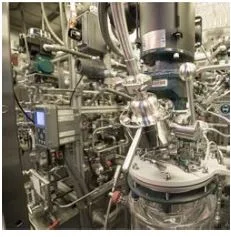It is widely agreed that if OLED is to be truly cost-competitive with LCD for television applications, the OLED materials must be printed instead of being deposited by vacuum thermal evaporation as they are today.

That means not only that the OLED materials must be reformulated to retain their characteristics in soluble form, but also that a new system for panel manufacturing be designed around solution processing, and that new equipment be created that can perform solution processing (part of which will be some kind of printing) at high volume and high yield. None of this is easy, but the payoff is, potentially, OLED TV sets that have a lower manufacturing cost than LCD-TVs do.
Yesterday, DuPont Displays announced the opening of a “scale-up manufacturing facility designed to deliver production scale quantities of advanced materials that enable large-format solution-based printed Organic Light Emitting Diode (OLED) displays.” The new facility is located at DuPont’s Stine-Haskell Research Center in Newark, Delaware.
The announcement quotes DuPont Display Global Business Director Avi Avula as saying, “Our vision is that OLEDs will become the display standard and to make that vision a reality, we are focused on helping our customers bring trhe cost of large sized OLED TVs down to less than $1000 by 2020.” By 2020. Wow!
This is not a completely crazy idea. If you have an efficient manufacturinig process, reasonable capital costs, and high manufaturing yield, the manufacturing cost should approach the cost of materials as manufacturing volume becomes large. And OLED has always promised a lower material-and-component cost than LCD. (No backlight unit and no matrix color filter, at least for some configurations.) It’s the other pieces of the puzzle that have been the problems.
So we had some questions for DuPont Displays, which we directed to Avi Avula via an email Q&A.
KW: Can you tell me who you are working with other than Kateeva? [On June 1, DuPont Displays and Kateeva (Newark, California) announced they would collaborate on optimizing inkjet printing from OLED-TV mass production. DuPont Displays, Kateeva Collaborate on OLED TVs – subscription required]
AA: In addition to our collaboration with Kateeva, and other equipment makers, we are actively engaged with the leading OLED display manufacturers to bring solution printed OLED technology to market as quickly as possible, however the names of our technology licensees and potential partners remain confidential. Our goal is to provide our customers with high performing materials that give them the freedom to choose whichever technology platform they prefer.
KW: Since UDC has the patents for phosphorescent OLEDs tied up, what are you doing to make efficient printed OLEDs?
AA: Materials are critical to the performance and efficiency of a printed OLED TV. We have a robust IP portfolio and we believe we offer the best performing solution OLED materials available in the market today. We have been developing our suite of advanced OLED materials for the last 15 years and they are highly regarded due to their long lifetime and deep color.
KW: Making a $1000 OLED-TV by 2020 requires that not only the materials be ready, but that an entire printed-OLED processing chain be designed, developed, constructed and further developed in R&D, pilot line, and volume-manufacturing implementations. That is a very demanding program
AA: Yes, this is a very demanding program, and an ambitious goal for the display industry. Many of our customers believe that printed OLED TVs can be made less expensively than LCD TVs, and we are working to support them on these initiatives. When OLED TVs are made inexpensively through solution printed technology, we believe OLEDs will become the display standard. We believe collaborations with regards to materials, process technology, and equipment will help achieve this goal.
—
Okay. This is me again. DuPont Display’s work on solution-processed materials is indeed very well respected, and Kateeva is believed to have solved many of the problems that have haunted ink-jet printing of functional materials. But you may have noticed that Avula gracefully side-stepped one of my questions, the one about how you can make efficient OLED-TVs without phosphorescent solution-processed materials. This is particularly telling since DuPont Display’s work is known to have been on fluorescent materials.
Perhaps I’m asking the wrong question. An inexpensive, solution-processed OLED-TV may not have to be as efficient as a conventional one as long as it is sufficiently efficient to earn the Energy Star label. Can DuPont Displays’ materials do that? Stay tuned. (KW)
Ken Werner is Principal of Nutmeg Consultants, specializing in the display industry, manufacturing, technology, and applications, including mobile devices and television. He consults for attorneys, investment analysts, and companies using displays in their products. You can reach him at [email protected].

